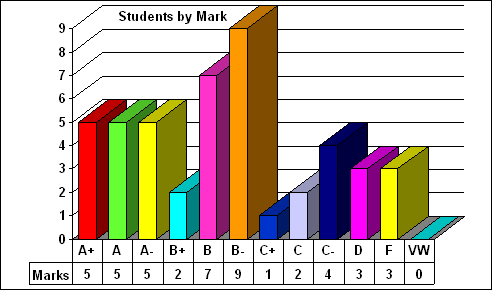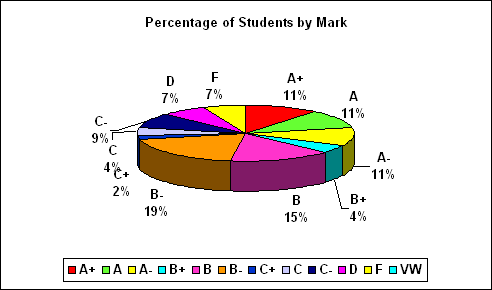My favorite course has continued to improve with new techniques. For the first time interactive clickers were used to encourage students to answer questions and receive credit (10%). The response to clickers was overwhelmingly positive. Students attended class much more frequently (75-80% versus below 50%), enjoyed the lectures more, felt more engaged, and learned the material. Many students take the course for an "easy credit" but leave with the understanding of the value and relevance of the material.
This course goes beyond Microsoft Office and teaches about computer hardware, some programming, and other topics in a broader instruction to Computer Science. Students did some basic programming in HTML and JavaScript. Many students really liked the HTML. The JavaScript was a little harder as it is exposes some of the difficult issues with programming. My acceptance rate for the programming has been consistently improving. The programming content was more streamlined and will continue to be focused on only the key concepts with lots of practice. We also covered computer organization, data representation, spreadsheets, databases, and some security. The notes are so good now that no one uses the textbook. It will just be on reserve in the library and not even recommended for the next class. The content of the course was similar to Spring 2008. The labs were basically identical.
Student performance improved considerably over Spring 2008 with a pass rate of 87% versus 65% and overall GPA of 2.77 versus 2.12. Performance increased on all exams especially midterm #2 (Javascript programming) where the average GPA was the highest ever for the course. The major difference was more students consistently attending class (did not have lots of low marks) and enough students getting the basics to pass the programming midterm. Still the programming remains the most challenging part of the course. Overall, this course is continuing to improve, and the goal now is to grow attendance to at least 100 students within the next 3 years. The enrolment was 46.
The course involved lab assignments on the computers, two midterm exams, and a final exam.
The class was at 9:30-10:30 a.m. Mondays/Wednesdays/Fridays in Arts 206. Students were led by a TA in 2 hour labs at various times.
Of the 46 registered students who started the course, 43 (93%) received a D or higher and 40 (87%) received a C- or higher. The average GPA was 2.78 or a B-. Charts showing the mark breakdown are below. There is no longer a bi-modal distribution. More students stayed engaged and were able to pass the course. The number of exceptional students was about the same.


The instructor rating of 4.77 was a slight improvement over last year. The course rating of 4.46 was about the same. The course got a little higher for challenging (3.88), but it is not intended to be a hard course. A continuing goal is to focus the material and only teach the most important topics instead of trying to cover everything. The programming was accepted by more students and can still be improved by spending more time on it while also reducing the amount of material covered. Continued to emphasize programming as "creative problem solving". Many students, especially arts majors, appreciate the creativity even though it may be challenging at first. The addition of clickers was very positive and their use will continue.
The labs were mixed. One TA did very well while the other had very negative reviews. The labs themselves are good, but there is still not a good connection with the TAs or motivation for students to attend. That is okay for earlier labs but not good for programming labs. The HTML lab continues to be the favorite. The programming labs just seem so out of place in terms of difficulty to the students. Continue to emphasize that the labs are there for learning and for preparation for the exams. They are "worth" more than the 20% to your grade - the practice is critical!
The course will always be challenging to teach as it is considered an "easy science credit" (and I do not dispute that label). However, there is no reason that it cannot be inspirational, fun, and allow students to learn a lot about computers that will be extremely valuable to them.